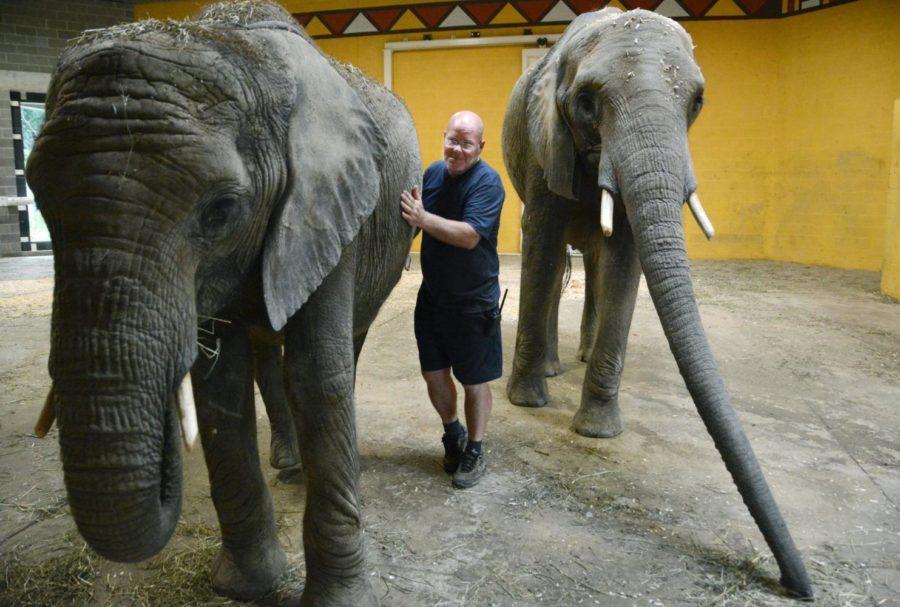Last summer, the Pittsburgh Zoo euthanized its only elephant calf — Little Bit, a premature three-month-old rejected by her mother who had stopped eating due to painful teething.
PETA criticized the zoo for the way it handled Little Bit’s health and death — and this wasn’t the first time. The animal rights organization has criticized the zoo before, including in 2014 when the U.S. Department of Agriculture investigated it for using dogs to herd its elephants.
The Pittsburgh Zoo has been criticized several times for its treatment of elephants and has earned the rank of the second-worst place for elephants in America. But despite this title, the zoo has decided to expand its elephant population further, applying to import elephant semen from Canada for breeding purposes. Barbara Baker, president and CEO of the zoo, said this move will introduce new genetics into the zoo’s elephant population to help ensure its growth in the future.
But the zoo elephant population shouldn’t grow, not in Pittsburgh and not anywhere else. Elephants born into captivity will be forced to lead a life full of physical and psychological health risks, being raised to attract and entertain people. Better options exist to help save elephants besides placing them in zoos that cannot meet their needs.
Elephants face extreme risks to their health if kept in zoos. Obesity, injury, stress and disease are parts of daily life for many of these animals. According to a Seattle Times analysis of elephant fatalities in zoos across the United States, the majority of deaths resulted from injury or disease linked to captivity, which could explain why wild elephants live on average at least 20 years more than their captive counterparts. Elephant calves born in captivity are thus born into lives of health problems and a likely premature death.
A less-visible suffering also exists for these animals behind a zoo’s bars. Elephants often display “zoochosis”— repetitive behavior ranging from head-bobbing to self-mutilation — that suggests depression and distress from a lack of stimulation. This atypical behavior isn’t seen in wild elephants, and is a product of zoos’ inability to account for the size and complexity of elephants’ social constructs and ecosystems.
The weight of scientific evidence regarding elephants’ failure to thrive in captivity, along with pressure from animal activists, has led at least 22 zoos to close or plan to close their elephant exhibits. Yet the power of these creatures to bring in visitors continues to outweigh the costs in many zoos across America, where approximately 230 elephants still live in captivity.
John Lewis, director of the Los Angeles Zoo, rejected the idea of a zoo-run sanctuary, fretting that visitor numbers would decrease because some would not “appreciate large enclosures with animals far away.”
But suburban families should not be the main priority of zoo owners and directors. If people charged with the safekeeping of endangered animals really did care, then they would start considering alternatives to exploiting them for the viewing pleasure of tourists and schoolchildren.
Some argue animals need zoos because there is no other alternative for protecting endangered creatures such as elephants. Robert Hoage, former public affairs director at the National Zoo, described zoos as, “not great places for elephants, but they are better [there] than dead.”
Of course, the dangers that elephants currently face in the wild are very real. Poaching continues unabated, with estimates of 55 slain elephants every day. The demand for ivory remains strong in countries like China, which is responsible for 70 percent of worldwide ivory demand.
But there is an alternative to zoos — sanctuaries.
Elephant sanctuaries are large facilities that care for elephants from zoos and circuses, and provide them with natural habitats that allow for protection, space and autonomy. They are funded by private donations and, unlike zoos, prioritize the elephants’ well-being by meeting their physical and social needs, and employing minimal human contact. The Elephant Sanctuary in Tennessee, which has provided refuge to 27 elephants, is certified by the Association of Zoos & Aquariums for demonstrating a commitment to exemplary animal care and welfare.
Some may fear that fewer elephants in zoos means that fewer people will become invested in their well-being and not care about their plight in the wild. But the opposite is true. Zoos create the idea that the elephants there are safe from harm and happy to entertain people. A global survey from World Association of Zoos & Aquariums found that zoo visits actually make people 17 percent less committed to take action on habitat protection and creation. Zoos ultimately do little to convince ordinary folks that they should care about wild elephants’ plight.
And zoos themselves aren’t proving they are a help to the endangered elephant population through breeding and raising the species in captivity — very few calves survive in the first place. The overall infant-mortality rate for elephants in zoos is 40 percent — nearly triple the rate of those in the wild — an indication that elephants’ failure to thrive in this environment may begin as early as conception.
Captivity is a terrible existence for any intelligent, self-aware species like elephants. By capturing and breeding these animals for public display, zoos are propagating a cycle of suffering that goes against their most basic proclaimed values. Zoos are not the paradises of conservation and education they claim to be, and better alternatives to them exist.
If the Pittsburgh Zoo really wants to help elephants, it needs to do so in ways other than trying to breed more elephants that could suffer in circumstances similar to Little Bit’s.



